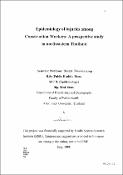บทคัดย่อ
Epidemiology of injuries among construction workers: A prospective study in northeastern ThailandThis study was 6 month follow-up study of injuries among construction workers conducted during late 1996 to early 1997 at the two large construction sites in a Northeastern province of Khon Kaen. It observed 50,387 worker-days from 966 workers.
There were 815 episodes of injuries, 660 episodes were the injuries where these injured workers stopped working for at least half an hour and 162 episodes where the workers stopped working for a day or more. Important characteristics of injuries, from a total of 815 episodes investigated at the workplace, were described in several aspects.
There were 653 out of 815 (80.1 percent) injuries the worker stopped working for less than one day and needed only first-aid medical care. There were 152 (18.7 percent) injured workers who stopped working for at least one day (lost work-day injuries) but were not hospitalized. Only 10 (1.2 percent) injured workers were hospitalized and, of course, lost work-day. The majority of injuries were laceration (42 percent), followed by abrasions (21 percent) and cuts or puncture wounds (20 percent). Contusion, abrasion and laceration were common among all body region whereas cut or puncture wound was found mostly injury of the limbs. There were 506 (62 percent) injured which resulted in blood loss-laceration and cut or puncture wound combined. For 71 percent of the 815 injuries the workers reports they were exhausted at the time of the injuries. Approximately one tenth of them said they were drunk.
The main causes of the injuries according to the injured workers themselves were their own carelessness or ignorance (39.1 percent) followed by unexpected events (19.3 percent) and events which were unavoidable (14.2 percent). Only 5.7 percent of all injured workers worked overtime, only 1.8 percent reported that they were not assigned to the rights jobs. Thus these two factors probably played little role in injuries. Factors found to significantly increase risk of injuries included working at the construction site where the work was intense, being carpenters, male workers, young workers, less working year of experience, being forced to work, lived with relatives house, and perceived that working as currently did will cause no injuries. These factors were also significantly related to lost work-time injuries except place of living whereas only type of work, age and working experience were they significantly associated with the lost work-days injuries.


